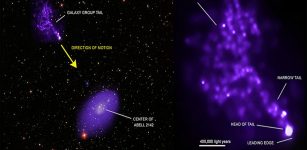Wandering Black Hole Found 4.5 Billion Light Years From Earth
MessageToEagle.com – An extremely luminous and peculiar object has been discovered by a team of astronomers using NASA’s Chandra X-ray Observatory and ESA’s XMM-Newton X-ray observatory.
Strangely, the object has been found outside the center of the lenticular galaxy GJ1417+52, located approximately 4.5 billion light years from Earth.

Astronomers believe that the object could be a wandering black hole that came from a small galaxy falling into a larger one.
It is possible that this black hole may originally have been at the center of a small galaxy that merged with GJ1417+52.
This new discovery supports a long-held theory about the existence of wandering black holes.
It has long been suggested that supermassive black holes (with some 100,000 to 10 billion times the sun’s mass) and even smaller, so-called intermediate mass black holes with masses from 100 and 100,000 times that of the sun – are located in the centers of most galaxies.

However, following a collision and merger with another galaxy containing a massive black hole – such black holes may be moved away from the center of a galaxy.
The X-ray output of XJ1417+52 is so high that astronomers classify this object as a “hyper-luminous X-ray source” (HLX). These are objects that are 10,000 to 100,000 times more luminous in X-rays than stellar black holes, and 10 to 100 times more powerful than ultraluminous X-ray sources, or ULXs.
At its peak XJ1417+52 is about ten times more luminous than the brightest X-ray source ever seen for a wandering black hole. It is also about 10 times more distant than the previous record holder for a wandering black hole.
A new study is published in The Astrophysical Journal.
MessageToEagle.com
Expand for references









